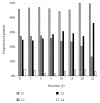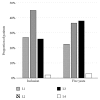Lipid and Bile Acid Dysmetabolism in Crohn's Disease
- PMID: 30402511
- PMCID: PMC6191959
- DOI: 10.1155/2018/7270486
Lipid and Bile Acid Dysmetabolism in Crohn's Disease
Abstract
Crohn's disease is one of the systemic autoimmune diseases. It commonly affects the small intestine and colon but may involve any portion of the gastrointestinal tract from the mouth to the anus. The most affected area by Crohn's disease is the distal part of the small intestine, in which the bile acid molecules are most efficiently reabsorbed. Bile acids form mixed micelles together with fatty acids, which function as a transport vehicle to deliver fatty acids to the apical membrane of enterocytes for absorption. Therefore, if the terminal ileum is impaired, bile acid malabsorption may occur, which may cause congenital diarrhoea in Crohn's disease. Similarly, the impairment of the terminal ileum also induces fatty acid malabsorption, which may influence the role of fatty acids in Crohn's disease. In contrast, a recent study reported that multidrug resistance protein 1 (MDR1) regulated effector T-cell function in the ileum from bile acid-driven oxidative stress and MDR1 loss of function in a subset of patients with Crohn's disease. However, the role of consumption of fatty acids in Crohn's disease remains to be fully elucidated. This review is aimed at providing an overview of some recent developments in research of Crohn's disease from comprehensive perspective with a focus on the connection between disease location and behaviour, lipid diets, and bile acid malabsorption.
Figures



Similar articles
-
Bile acid metabolism and plasma protein turnover in Crohn's disease.Scand J Gastroenterol. 1976;11(7):721-7. Scand J Gastroenterol. 1976. PMID: 996438
-
The Xenobiotic Transporter Mdr1 Enforces T Cell Homeostasis in the Presence of Intestinal Bile Acids.Immunity. 2017 Dec 19;47(6):1182-1196.e10. doi: 10.1016/j.immuni.2017.11.012. Immunity. 2017. PMID: 29262351 Free PMC article.
-
CAR directs T cell adaptation to bile acids in the small intestine.Nature. 2021 May;593(7857):147-151. doi: 10.1038/s41586-021-03421-6. Epub 2021 Apr 7. Nature. 2021. PMID: 33828301 Free PMC article.
-
Altered enterohepatic circulation of bile acids in Crohn's disease and their clinical significance: a new perspective.Expert Rev Gastroenterol Hepatol. 2013 Jan;7(1):49-56. doi: 10.1586/egh.12.66. Expert Rev Gastroenterol Hepatol. 2013. PMID: 23265149 Review.
-
Obeticholic acid for severe bile acid diarrhea with intestinal failure: A case report and review of the literature.World J Gastroenterol. 2018 Jun 7;24(21):2320-2326. doi: 10.3748/wjg.v24.i21.2320. World J Gastroenterol. 2018. PMID: 29881241 Free PMC article. Review.
Cited by
-
Deoxycholic acid aggravates necrotizing enterocolitis through downregulation of mesenchymal-epithelial transition factor expression.Braz J Med Biol Res. 2024 Dec 2;57:e14046. doi: 10.1590/1414-431X2024e14046. eCollection 2024. Braz J Med Biol Res. 2024. PMID: 39630809 Free PMC article.
-
Untargeted serum metabolomics reveals specific metabolite abnormalities in patients with Crohn's disease.Front Med (Lausanne). 2022 Sep 8;9:814839. doi: 10.3389/fmed.2022.814839. eCollection 2022. Front Med (Lausanne). 2022. PMID: 36160171 Free PMC article.
-
Lipid Changes After Induction Therapy in Patients with Inflammatory Bowel Disease: Effect of Different Drug Classes and Inflammation.Inflamm Bowel Dis. 2023 Apr 3;29(4):531-538. doi: 10.1093/ibd/izac100. Inflamm Bowel Dis. 2023. PMID: 35590447 Free PMC article.
-
Identifying metabolic shifts in Crohn's disease using' omics-driven contextualized computational metabolic network models.Sci Rep. 2023 Jan 5;13(1):203. doi: 10.1038/s41598-022-26816-5. Sci Rep. 2023. PMID: 36604447 Free PMC article.
-
Serum Bile Acids Profiling in Inflammatory Bowel Disease Patients Treated with Anti-TNFs.Cells. 2019 Aug 2;8(8):817. doi: 10.3390/cells8080817. Cells. 2019. PMID: 31382518 Free PMC article.
References
-
- On Behalf of the Guidelines Project Group of the Research Group of Intractable Inflammatory Bowel Disease subsidized by the Ministry of Health, Labour and Welfare of Japan and the Guidelines Committee of the Japanese Society of Gastroenterology, Ueno F., et al. Evidence-based clinical practice guidelines for Crohn’s disease, integrated with formal consensus of experts in Japan. Journal of Gastroenterology. 2013;48(1):31–72. doi: 10.1007/s00535-012-0673-1. - DOI - PMC - PubMed
Publication types
MeSH terms
Substances
LinkOut - more resources
Full Text Sources
Medical
Research Materials

